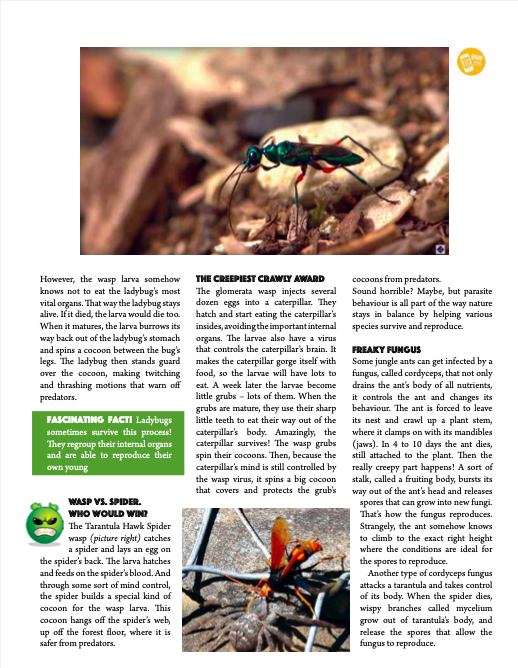
ZOMBIE WASP MASTERS
Meet some of the ickiest parasites in the insect world: The Zombie cockroach, The Ladybug Babysitter, Wasp vs. Spider, The Creepiest Crawly Award, and Freaky Fungus!
Nature is beautiful. But the things some creatures do to each other in order survive and reproduce are… well, kind of gross. Some insects actually use chemicals to control another bug’s mind. Here are some creepy examples from the wasp family.
THE ZOMBIE COCKROACH
The emerald cockroach wasp lives in tropical areas of Asia, Africa, and the Pacific islands. This wasp will sting a cockroach to paralyze it. Then it puts its stinger right into the cockroach’s brain and injects brain chemicals, called neurotransmitters, that take away the roach’s ability to move of its own free will. When the roach recovers from the paralyzing sting, the wasp makes the wasp walk into its underground nest. The wasp then lays an egg on the cockroach’s stomach and barricades the roach into the nest with bits of twigs and pebbles. The cockroach is alive and could dig its way out, but it just sits there because the wasp is controlling its mind. When the wasp’s egg hatches, the grub (the wasp larva) burrows into the roach’s body and slowly eats the roach’s internal organs. In about a month, a fully grown wasp emerges from the nest.
THE LADY BUG BABYSITTER
The ladybird parasite wasp catches a ladybug and injects an egg into the bug’s body. When the egg hatches, the larva grows inside the ladybug and, as with the cockroach, starts eating it from the inside out. However, the wasp larva somehow knows not to eat the ladybug’s most vital organs. That way the ladybug stays alive. If it died, the larva would die too. When it matures, the larva burrows its way back out of the ladybug’s stomach and spins a cocoon between the bug’s legs. The ladybug then stands guard over the cocoon, making twitching and thrashing motions that warm off predators.
Fascinating fact! Ladybugs sometimes survive this process! They regroup their internal organs and are able to reproduce their own young.


WASPS VS. SPIDER. WHO WOULD WIN?
The Tarantula Hawk Spider wasp (picture right) catches a spider and lays an egg on the spider’s back. The larva hatches and feeds on the spider’s blood. And through some sort of mind control, the spider builds a special kind of cocoon for the wasp larva. This cocoon hangs off the spider’s web, up off the forest floor, where it is safer from predators.
THE CREEPIEST CRAWLY AWARD
The glomerata wasp injects several dozen eggs into a caterpillar. They hatch and start eating the caterpillar’s insides, avoiding the important internal organs. The larvae also have a virus that controls the caterpillar’s brain. It makes the caterpillar gorge itself with food, so the larvae will have lots to eat. A week later the larvae become little grubs – lots of them. When the grubs are mature, they use their sharp little teeth to eat their way out of the caterpillar’s body. Amazingly, the caterpillar survives! The wasp grubs spin their cocoons. Then, because the caterpillar’s mind is still controlled by the wasp virus, it spins a big cocoon that covers and protects the grub’s cocoons from predators. Sound horrible? Maybe, but parasite behaviour is all part of the way nature stays in balance by helping various species survive and reproduce.
FREAKY FUNGUS
Some jungle ants can get infected by a fungus, called cordyceps, that not only drains the ant’s body of all nutrients, it controls the ant and changes its behaviour. The ant is forced to leave its nest and crawl up a plant stem, where it clamps on with its mandibles (jaws). In 4 to 10 days the ant dies, still attached to the plant. Then the really creepy part happens! A sort of stalk called a fruiting body, bursts its way out of the ant’s head and releases spores that can grow into new fungi. That’s how the fungus reproduces. Strangely, the ant somehow knows to climb to the exact right height where the conditions are ideal for the spores to reproduce. Another type of cordyceps fungus attacks a tarantula and takes control of its body. When the spider dies, wispy branches called mycelium grow out of tarantula’s body, and release the spores that allow the fungus to reproduce.
